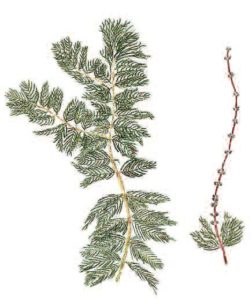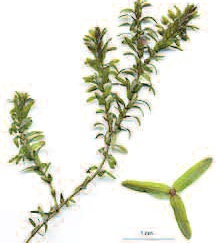Webber Pond vegetation: weeds or milfoil?
 by Roland D. Hallee
by Roland D. Hallee
There appears to be misconceptions, or maybe misinformation, circulating that the proliferating vegetation in Webber Pond is Eurasian milfoil.
Nate Gray, regional biologist with the Maine Department of Marine Resources was summoned by Webber Pond Association President Frank Richards to investigate. Gray responded by making a trip to the pond. In a boat, they entered the “field” of weeds at the north end of the lake. Upon close inspection, Gray concluded, as have others, that the vegetation is Elodea canadensis, or American pondweed or waterweed. Gray elaborated that the plants are a major nuisance, but they are harmless.

Eurasian milfoil
Richards said, “Nate is a qualified person. He and any other qualified person will confirm that it’s Elodea.”
American Waterweed or Pondweed is a perennial aquatic plant, and is native to most of North America.
The plant grows rapidly in favorable conditions and can choke shallow ponds and canals. It requires summer water temperatures of 68° – 77° and moderate to bright light.
Young plants initially start with a seedling stem with roots growing in mud at the bottom of the lake. More roots are produced at intervals along the stem, which may hang free in the water or anchor into the bottom. It grows indefinitely at the stem tips, and single specimens may reach lengths of 9-1/2 feet or more.
It lives entirely under water, with the only exception being the small white or pale purple flowers which float to the surface but are still attached to the plant by delicate stems.

American pondweed
The plant will spawn seed capsules that will spread and ripen under water. They flower from May to October.
Elodea canadensis is native to most of North America and was used as an aquarium plant.
On the other hand, Eurasian milfoil, Myriophyllum spicatum, was likely first introduced to North America in the 1940s. By the mid-1970s, water milfoil had covered thousands of acres in British Columbia and Ontario. It is now found across most of North America where it is recognized as a noxious weed.
In lakes or ponds where native aquatic plants are not well established, the Eurasian plant can quickly spread. It can be deduced that native aquatic plants have established themselves firmly in Webber Pond. The weed can grow from broken off stems which increases the rate in which the plant can spread and grow. That is why it is important to check all boats, propellers and trailers before launching the vessel in various lakes. Plants can easily be transported from one lake to another.
Since 2000, hand-harvesting of milfoils has shown much success as a management technique. It is virtually impossible to completely irradicate the species once it has established itself. Therefore, continuous maintenance must be done in order to control its range.
But getting back to Webber Pond, biologists at the DMR have assured everyone that the weeds in Webber Pond are not the invasive milfoil, but the annoying pondweed.
Many anglers have expressed frustration when trying to navigate the lake, or attempt to put in a day of fishing. Some areas of the lake are virtually impassable by boat.
According to Richards, “this is more of an instance where Mother Nature has presented us with unmanageble conditions for this year.”
Responsible journalism is hard work!
It is also expensive!
If you enjoy reading The Town Line and the good news we bring you each week, would you consider a donation to help us continue the work we’re doing?
The Town Line is a 501(c)(3) nonprofit private foundation, and all donations are tax deductible under the Internal Revenue Service code.
To help, please visit our online donation page or mail a check payable to The Town Line, PO Box 89, South China, ME 04358. Your contribution is appreciated!



Leave a Reply
Want to join the discussion?Feel free to contribute!